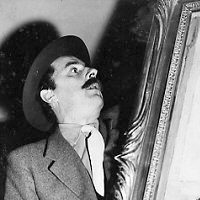TPL_JAE_ACC_MAIN_HOME_CONTENT
Nude (n. 1)
Oil on sanded canvas, 1956, Bianchedi Bettoli / Vallunga Collection, 75x51 cm with frame and passe-partout 97x71.5, Inv. n. 1763
This painting was executed in the midst of the discovery of sand as a base for painting, following a phase of research between 1950 and 1953 when this material sometimes appeared as an expressive element beside the traditional application of oil colours.
The pale sandy base is predominant here, even though it is usually dark; the lines of the drawing are similar to those of works on paper, free and vibratile on the surface, to outline "a full-page" portrait of a girl that will become instead, after the female nudes featured in the paintings of his years in Faenza, one of the icons of Gentilini's painting: the gentility of the pose, the pensive gaze speaks to us of the softness and physical fragility typical of "his" women.
And yet, it seems that the subject is not the focus of Gentilini's interest, but rather the tracing of the line, vibratile, that illuminates the contours of the volumes defined in positive-negative, almost monochrome, and of mysterious shadows. (from the notes of Laura Turco Liveri for the catalogue of the Bianchedi-Bettoli/Vallunga Collection published in 2012 by the Bononia University Press).




